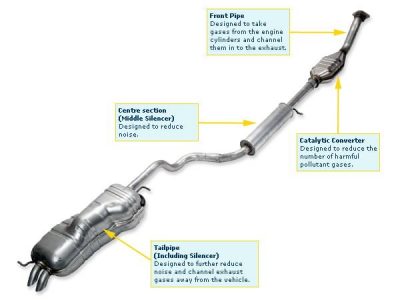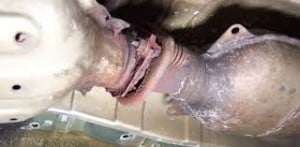Can You Drive a Car Without Exhaust Pipe
 Exhaust leaks can range from very serious problems to an issue that seems to make your car or truck sound really cool and go faster. In this article, we will talk about your vehicle's exhaust system, symptoms of a leak and what you can do about.
Exhaust leaks can range from very serious problems to an issue that seems to make your car or truck sound really cool and go faster. In this article, we will talk about your vehicle's exhaust system, symptoms of a leak and what you can do about.
What does the exhaust system do?
Your vehicle's exhaust system serves a relatively simple purpose but sometimes accomplishes it in a complicated way. The primary goal of your vehicle's exhaust system is to direct the gases coming from your combustion chamber to a safe place. The safest place is somewhere outside of your vehicle, far from you and any windows or openings in your vehicle which usually means somewhere under your rear bumper. Your exhaust system's secondary purpose is to muffle the sound of the explosions that are happening inside your engine as well as the sound of high-velocity gases escaping from your tailpipe. The complications come in when you look at the route that your exhaust will have to take and keep in mind that it can get to be extremely hot. Lastly, your engine vibrates and moves around quite a bit while you are driving depending on whether you are accelerating heavily, downshifting or just idling. So your exhaust has to safely carry dangerous fumes quickly and quietly to the back of your car without getting anything too hot.
To accomplish this your exhaust system uses a variety of manifolds, heat shields, pipes, joints, flexible unions, mufflers, and rubber hangers. The extreme temperature swings – from ambient temperature to possibly over 1200 degrees – cause a lot of stress on all of these components. Also, one of the byproducts of good combustion in your vehicle's engine is water. This water often exits your exhaust in vapor form but on cold days or short drives, the inside of your exhaust system can be left wet, which causes the metal pipes and components to rust. Lastly, your exhaust system runs along the bottom of your vehicle so it is exposed to all of the elements from road dust and debris to rain, salt, snow, and ice.
Your vehicle's exhaust system lives a tough life so at some point in the life of your vehicle it will likely need to be replaced or repaired. Some of the repairs on your exhaust system can be done yourself, while others should be left up to a professional.
How to tell if you have an exhaust leak
Repairing your exhaust system starts with identifying where the problem is. It can be difficult to check for an exhaust leak and find the problem since your exhaust pipe gets so hot. You should never touch or handle any part of your exhaust system if your vehicle has been driven anytime in the last few hours! Start with a visual inspection. Pop your hood and find the exhaust manifold. It will be where the exhaust gases exit your vehicle's engine. It likely will look rusty and either be a number of tubes, or one large tube. Sometimes they are covered by a heat shield so look hard. From there, follow the piping back under your vehicle all the way to the rear. Look for any holes or places where the pipe has broken or come apart. Also inspect each of the exhaust components as you go back. There may be one or multiple catalytic converters, resonators or mufflers. These will look like large metal tubes or boxes connected along the exhaust piping. Check all of these for holes, dents or creases. Don't forget to check the top of each component with a mechanic's mirror.

What does an exhaust leak sound like?
You can also do an audible inspection for an exhaust leak if you know what a leak sounds like. With your vehicle running start in the engine bay. See if you can hear a distinct noise coming from near the exhaust manifold. In this area, an exhaust leak will sound more like a ticking or puffing. Next, listen for leaks at any union or joints in your exhaust system. Once you get to your catalytic converter and go back from there, a leak will sound more like a buzz, hum or your car or truck will sound like a hotrod. Usually, the louder the noise, the closer to the engine it is. During this inspection, it may be helpful to have a friend rev in the engine intermittently so you can hear the changes in exhaust sound. Remember, never touch the exhaust components during this inspection, they'll be hot!
How to fix an exhaust leak from the manifold or joints
If you discover your exhaust leak to be coming from the exhaust manifold or one of the joints in your exhaust system you may be able to seal the leak simply by changing the gasket. Each joint in your exhaust system will have a gasket that can be replaced, but remember the bolts may be hard to remove as they are usually rusty.
How to repair an exhaust leak from a break or hole
If you discover your leak to be from a break or hole in your exhaust system it will be difficult to fix it on your own. You may be able to replace just the section of pipe or exhaust component by disconnecting the two closes joints and replacing the entire section of exhaust. That option is often expensive and can be difficult to do because of rusted bolts and connections. The best thing to do in this case is to take your vehicle to a muffler repair shop that can weld in a new section of pipe or component to make sure your exhaust system is leak tight.
Exhaust leaks can be very dangerous as they will let exhaust gases into the cabin of your vehicle. Exhaust gases are not only bad for the environment, but they are bad for you! Inhaling vehicle exhaust fumes can make you uncomfortable in the short term but may lead to serious health problems and even death! If at any point you smell exhaust fumes in your vehicle, have it checked out by an exhaust shop immediately.
Pictures provided by: www.kwik-ft.com and www.ultimatesubaru.com
62 responses to "How To Fix an Exhaust Leak"
Can You Drive a Car Without Exhaust Pipe
Source: https://gobdp.com/blog/can-fix-exhaust-leak/
0 Response to "Can You Drive a Car Without Exhaust Pipe"
Post a Comment